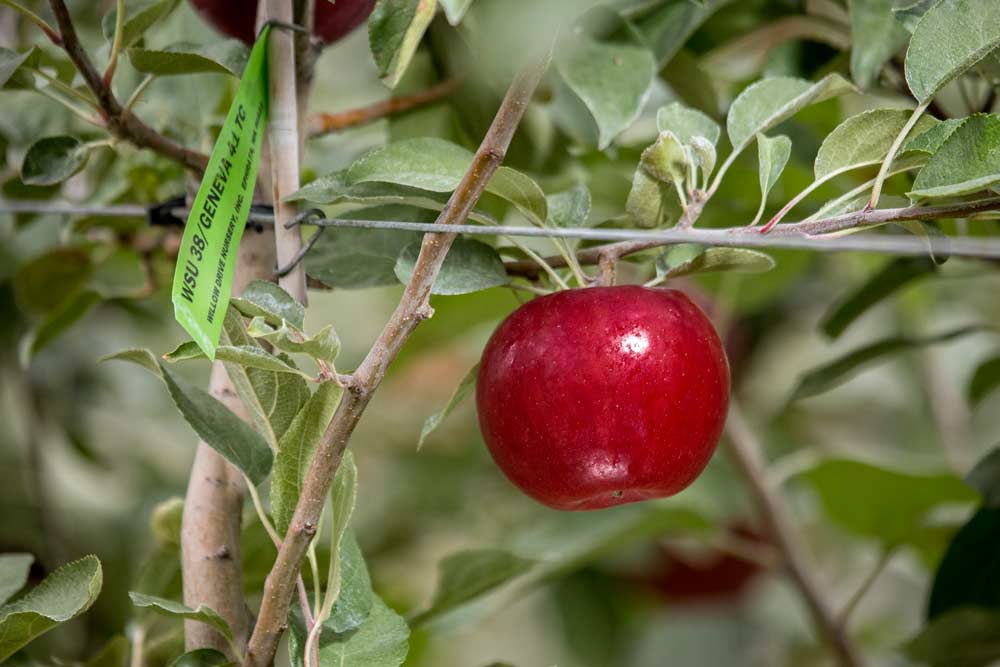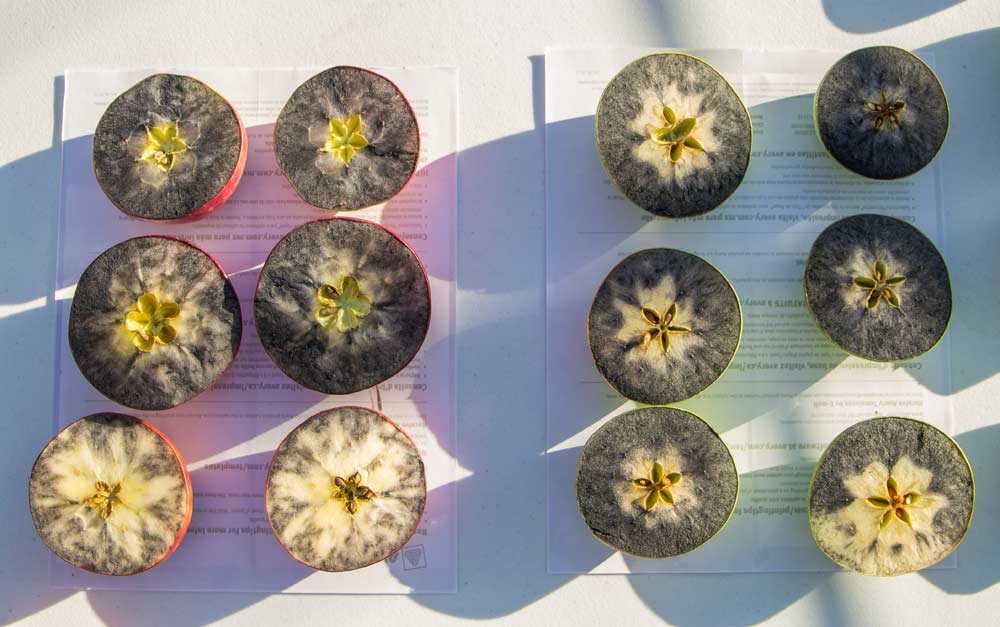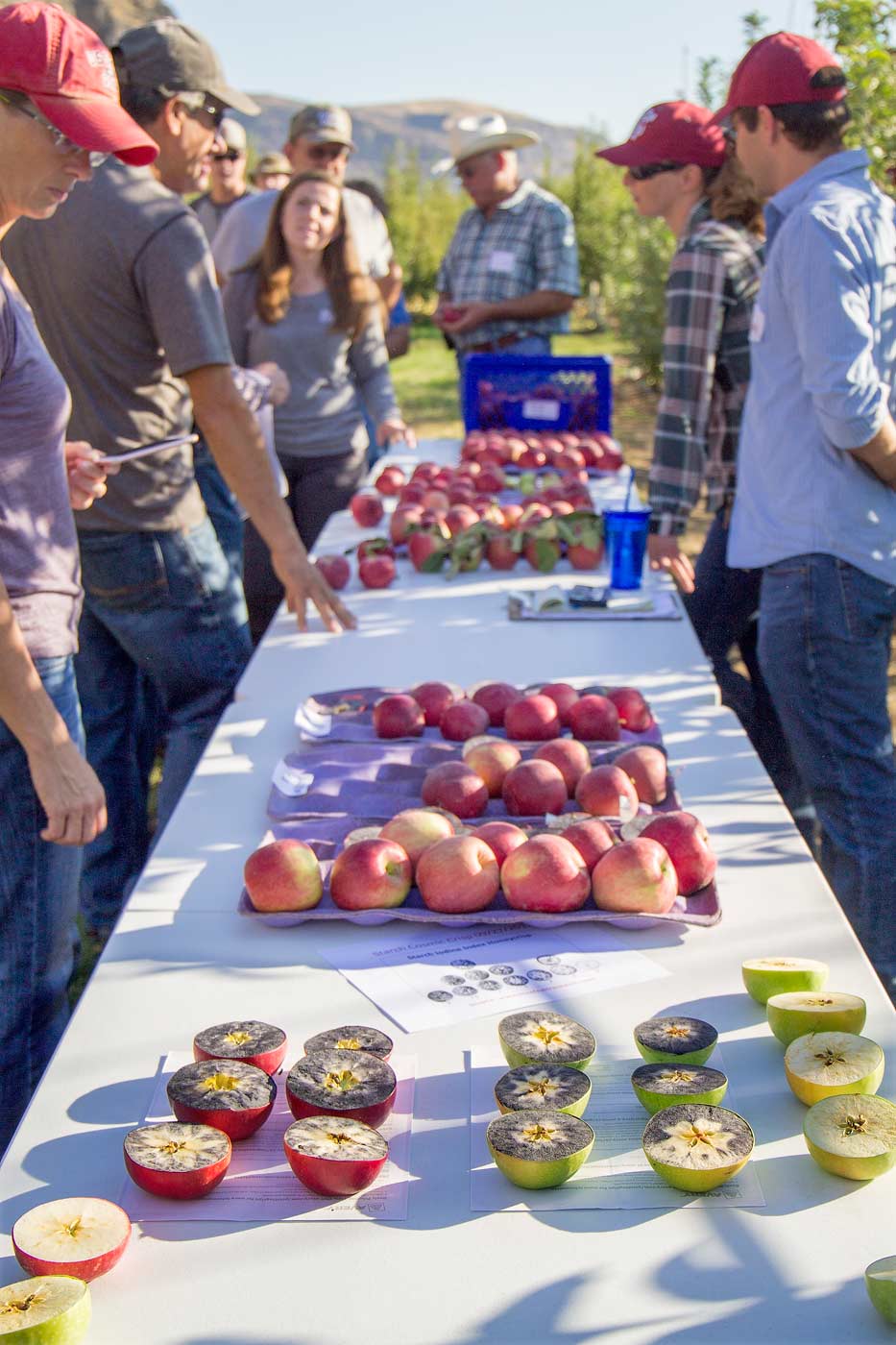
Cosmic Crisp on Geneva 41 rootstock before harvest in October at Washington State University’s Sunrise research orchard in Rock Island, Washington. (TJ Mullinax/Good Fruit Grower)
The new Washington State University apple variety WA 38, to be sold under the trade name Cosmic Crisp, is easy to store and suffers very few storage maladies if growers pay attention to best practices in the field.
That’s the finding from researchers who are reviewing the variety and offering tips to growers who planted it for the first time earlier this year.
“That’s a big difference from other varieties, not having to worry about 40 percent losses in storage due to some disease or another,” said Ines Hanrahan, project manager for the Washington Tree Fruit Research Commission (WTFRC). “You still have to manage the growing of the fruit and the harvest, but once you have a good product in the bin, there’s less worry having something wrong once it’s in storage.”
A cross between Enterprise and Honeycrisp bred at WSU, the apple was released only after years of orchard trials.
Washington growers began planting the first trees in the spring, and roughly 11 million trees are expected to be in the ground in just three short years.
Knowing what the variety needs in the orchard and packing house is crucial to success.
Researchers for the WTFRC and WSU have been evaluating fruit from the trees to better understand and recommend best horticultural and packing practices for Cosmic Crisp.
They presented examples of the fruit — perfect-looking Cosmic Crisp apples and apples shaped less than ideally, as well as fruit with various blemishes — during a field day in September.
Here are a few of their recommendations:

Researchers are working to develop a starch scale for WA 38, the new Washington State University apple to be sold under the name Cosmic Crisp. (Shannon Dininny/Good Fruit Grower)
—Typically, growers will have a two-week window to harvest fruit that is suitable for long-term storage. Most varieties offer only a five-day window. “It gives you some time, some play, during harvest, if for example you don’t have enough pickers,” Hanrahan said.
—The variety is a lot less prone to sunburn than many other varieties, but can still get sunburn in afternoon sunlight without overhead cooling. Also, overhead cooling doesn’t appear to impede the fruit from coloring.
“However, if you have a block that is overly vigorous and has no overhead cooling, you can have color problems just like other varieties,” she said. Usually, color sets three to four weeks before harvest.
—Growers need to monitor starch levels and watch for splits, which mainly affect overripe fruit. Typically, only 2 percent of fruit will split, but if growers wait too long and the starch level goes to four (on a one-to-six scale), splits can go up to 20 percent.
“Start looking for splits at starch level two, then just keep watching to know if your orchard is susceptible,” she said. Researchers are working to come up with a starch scale for the variety by the end of the year.
—Firmness ranges between 18 and 21 pounds in normal years. This year, researchers have harvested fruit at 17 pounds. However, the fruit loses very little firmness in storage.
—A few other notes: The variety suffers from no internal browning or scald. There is some green spot and cracking, but researchers don’t think the latter is a concern unless growers miss their harvest window and harvest too late, Hanrahan said.
Researchers have begun a couple of new projects to continue evaluating the variety. They are working to develop recommendations on either preharvest fungicide applications or applications as soon as the fruit is picked and placed into storage.
The variety has a lot of sugar and there are some stem punctures, so to avoid losses in storage, they are recommending fungicide applications.
They also are trying to use dynamic controlled atmosphere storage (DCA) to see if the fruit can be stored under organic storage regimens and determining when stem punctures might occur — during picking, placing of fruit in the bin or running fruit over the packing line. Researchers are conducting a full test this year to help to advise growers on whether to stem clip. •

Researchers from Washington State University and the Washington Tree Fruit Research Commission share the latest findings into growing the new WSU apple variety, WA 38, also known as Cosmic Crisp, at a field day at WSU’s Sunrise Orchard in Rock Island, Washington, in September. (Shannon Dininny/Good Fruit Grower)
– by Shannon Dininny






Leave A Comment